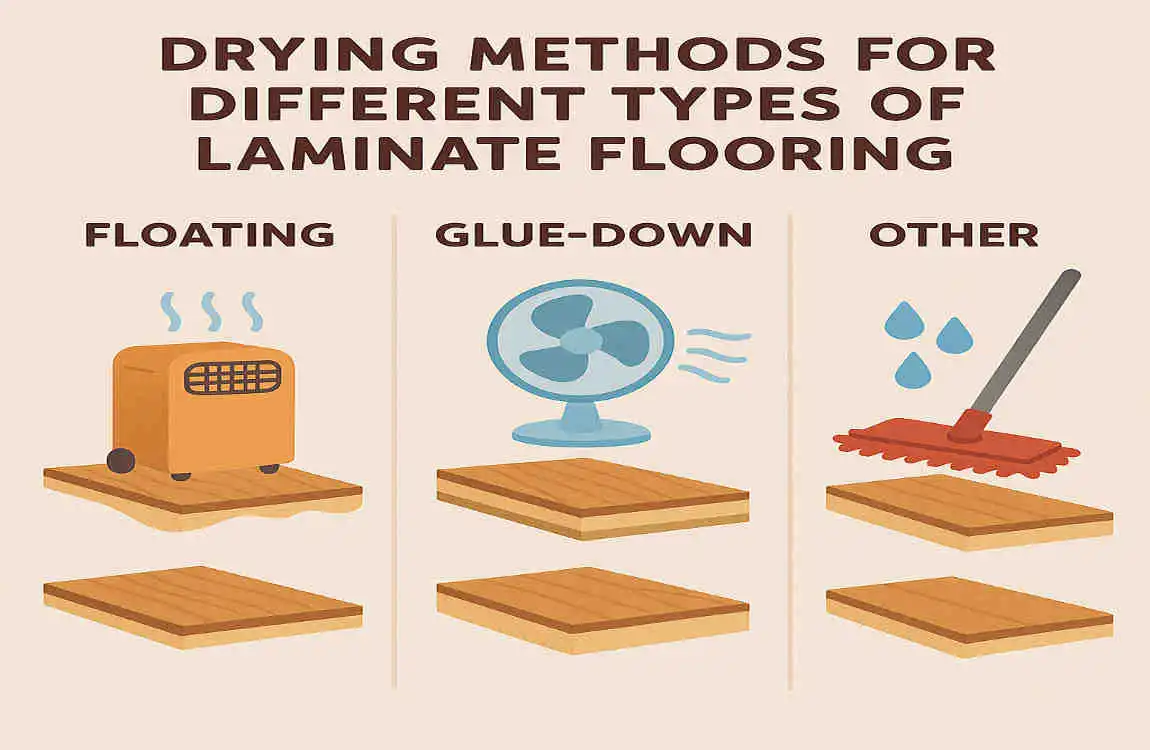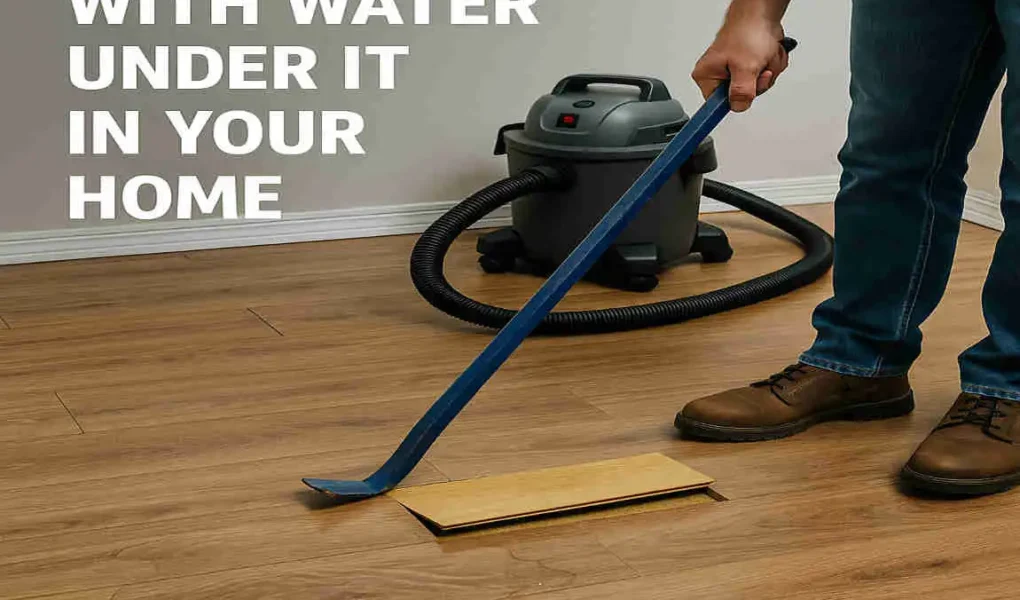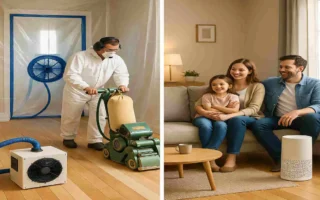To dry laminate flooring with water underneath, start by quickly removing as much water as possible using towels or a wet/dry vacuum. Next, improve air circulation by opening windows and using fans, and a dehumidifier to pull moisture out from under the home flooring. Act fast to prevent swelling or warping of the laminate.
Laminate flooring is a synthetic product designed to mimic the look of natural wood or stone. Each layer serves a specific purpose. The top layer is a clear protective coating that shields it from scratches and stains.
Beneath this lies an image layer featuring high-resolution designs that replicate various materials. This gives laminate its attractive appearance without the hefty price tag of real wood or tile.
The core layer provides stability and strength, typically made from high-density fiberboard (HDF). This is crucial for maintaining the floor’s shape over time.
Common causes of water damage on laminate flooring

Water damage on laminate flooring can occur from various sources. One common culprit is leaks in plumbing lines, which may go unnoticed until the damage becomes severe.
Another frequent cause is flooding. Heavy rains or a burst pipe can quickly inundate your space, leaving water trapped under the laminate
Humidity also plays a role; excessive moisture in the air can seep into seams and joints over time, causing warp and swelling.
Accidental spills are often overlooked as well. Whether it’s a spilled drink or a pet accident, if not cleaned promptly, these liquids can lead to significant issues beneath the surface.
Steps to take immediately after discovering water under your laminate flooring

The moment you notice water under your laminate flooring, swift action is crucial. Begin by identifying the source of the leak—whether it’s a burst pipe or an overflowing appliance. Fixing that issue should be your top priority.
Next, carefully move any furniture off the affected area. This prevents further damage and allows for easier access to the flooring.
Use towels or a wet/dry vacuum to absorb as much water as possible from the surface. The sooner you remove standing water, the better chance you have of reducing lasting effects.
Open windows and doors to increase ventilation in the space. Fresh air circulation helps speed up drying time significantly.
If there are moisture pockets beneath planks, consider lifting them gently to allow airflow underneath. Assess whether additional materials like fans or dehumidifiers expedite this process further.
significantly reduces the likelihood of mold growth.
Materials needed for drying laminate flooring

To effectively dry laminate flooring, gather a few essential materials. Start with towels or absorbent rags for quick cleanup of any standing water. These will help soak up moisture before it seeps into the floor.
Next, consider fans or blowers to enhance airflow in the affected area. Position them strategically to create a cross breeze that encourages faster evaporation.
Dehumidifiers are another crucial tool. They work wonders by removing excess humidity from the air, speeding up the drying process, and reducing the risk of mold growth.
If you have access to wet/dry vacuums, put them to use as well. They can extract trapped water beneath your flooring without damaging it.
Keep some wood blocks handy. Elevating furniture off the ground can prevent further absorption and damage while everything dries out properly.
Drying methods for different types of laminate flooring (floating, glue-down, etc.)

When it comes to drying laminate flooring, different installation methods call for tailored approaches. Floating floors are house designed with expansion gaps and can be lifted easily. Start by removing planks near the water source to expose the subfloor and facilitate airflow.
For glue-down laminate, you’ll need a more cautious approach. Avoid pulling up tiles unless necessary, as this could damage the adhesive layer. Instead, focus on absorbing moisture using towels or mops while ensuring good ventilation in the area.
Using fans can significantly enhance the drying speed of all types of laminate. Position them strategically to maximize air circulation under and around affected areas.
Dehumidifiers are also beneficial, especially in humid climates where moisture lingers longer than desired. They help extract excess humidity from both the air and your flooring materials without risking further damage.
Tips and tricks for preventing further damage and mold growth

To prevent further damage after water exposure, act quickly. Drying your laminate flooring is crucial, but also focus on the surrounding environment. Keep windows open to promote airflow.
Using fans can help circulate air effectively. Position them strategically around the affected area for maximum impact. A dehumidifier can be a valuable tool in this situation, drawing moisture from the air and helping to speed up the drying process.
Regularly inspect areas prone to leaks or spills. Pay attention to appliances like dishwashers or refrigerators that might cause unexpected water issues.
Consider applying a sealant specifically house designed for laminate flooring as an added protective measure. This can help deter future water penetration.
Keep humidity levels low within your home by using exhaust fans in kitchens and bathrooms. This simple step significantly reduces the likelihood of mold growth.
FAQ: How to Dry Laminate Flooring with Water Under It
Can I Dry Laminate Flooring Myself?
Yes, you can dry laminate flooring yourself if the water damage is minor and you act quickly. However, for extensive damage or if you’re unsure about the process, it’s best to consult a professional to avoid further damage.
What Causes Water to Get Under Laminate Flooring?
Water can get under laminate flooring due to various reasons, such as:
- Spills and floods: Accidental spills or flooding from appliances like washing machines or dishwashers.
- Leaks: Leaking pipes, toilets, or roofs can cause water to seep under the flooring.
- High humidity: Excessive moisture in the air can lead to condensation under the flooring.
How Do I Know if There’s Water Under My Laminate Flooring?
Look out for these signs:
- Swelling or buckling: The flooring may start to swell or buckle in areas where water has accumulated.
- Discoloration: You might notice discoloration or dark spots on the surface of the laminate.
- Soft or spongy feel: If the flooring feels soft or spongy underfoot, it could be a sign of water damage.
What Should I Do Immediately After Discovering Water Under My Laminate Flooring?
- Turn off the water source: If the water is coming from a leak, turn off the water supply to prevent further damage.
- Remove standing water: Use towels, mops, or a wet/dry vacuum to remove any standing water on the surface.
- Ventilate the area: Open windows and doors to promote air circulation and speed up the drying process.
How Do I Dry Laminate Flooring?
Follow these steps to dry your laminate flooring:
Remove Baseboards and Trim
Carefully remove the baseboards and trim around the affected area to allow better access to the subfloor.
Lift the Affected Boards
Gently lift the affected laminate boards using a pry bar or a flathead screwdriver. Be careful not to damage the tongue and groove system.
Dry the Subfloor
Use fans, dehumidifiers, or a wet/dry vacuum to dry the subfloor thoroughly. Ensure the subfloor is completely dry before reinstalling the laminate.
Check for Damage
Inspect the lifted laminate boards for any signs of damage, such as warping or swelling. If the damage is severe, you may need to replace the affected boards.
Reinstall the Laminate
Once the subfloor is dry, reinstall the laminate boards, ensuring they fit snugly and securely.
How Long Does It Take to Dry Laminate Flooring?
The drying time depends on the extent of the water damage and the humidity levels in your home. In general, it can take anywhere from a few days to a week or more for the subfloor to dry completely.
Can I Use a Heater to Dry Laminate Flooring?
While a heater can help speed up the drying process, be cautious not to use excessive heat, as it can cause the laminate to warp or crack. Keep the temperature moderate and ensure good air circulation.




